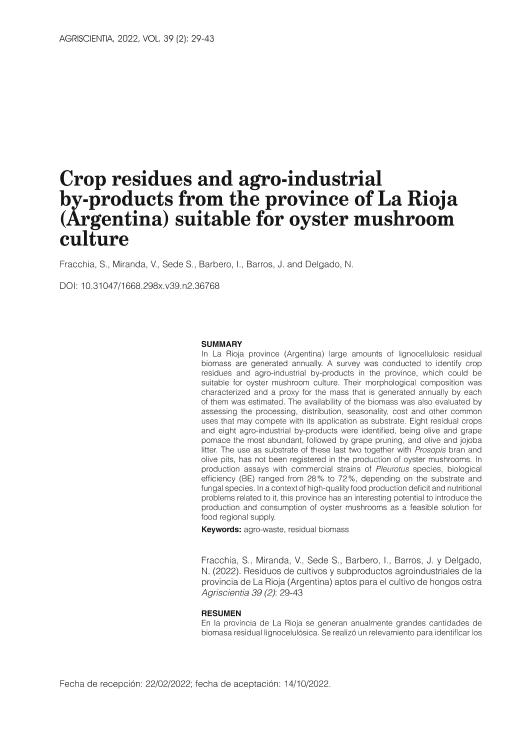Mostrar el registro sencillo del ítem
dc.contributor.author
Fracchia, S.
dc.contributor.author
Miranda, V.
dc.contributor.author
Sede, Silvana Mabel

dc.contributor.author
Barbero, I.
dc.contributor.author
Barros, J.
dc.contributor.author
Delgado, Nicolás

dc.date.available
2023-10-03T15:27:49Z
dc.date.issued
2022-10
dc.identifier.citation
Fracchia, S.; Miranda, V.; Sede, Silvana Mabel; Barbero, I.; Barros, J.; et al.; Crop residues and agro-industrial by-products from the province of La Rioja (Argentina) suitable for oyster mushroom culture; Universidad Nacional de Cordoba. Facultad de Ciencias Agropecuarias; AgriScientia; 39; 2; 10-2022; 29-43
dc.identifier.issn
0327-6244
dc.identifier.uri
http://hdl.handle.net/11336/213955
dc.description.abstract
In La Rioja province (Argentina) large amounts of lignocellulosic residual biomass are generated annually. A survey was conducted to identify crop residues and agro-industrial by-products in the province, which could be suitable for oyster mushroom culture. Their morphological composition was characterized and a proxy for the mass that is generated annually by each of them was estimated. The availability of the biomass was also evaluated by assessing the processing, distribution, seasonality, cost and other common uses that may compete with its application as substrate. Eight residual crops and eight agro-industrial by-products were identified, being olive and grape pomace the most abundant, followed by grape pruning, and olive and jojoba litter. The use as substrate of these last two together with Prosopis bran and olive pits, has not been registered in the production of oyster mushrooms. In production assays with commercial strains of Pleurotus species, biological efficiency (BE) ranged from 28 % to 72 %, depending on the substrate and fungal species. In a context of high-quality food production deficit and nutritional problems related to it, this province has an interesting potential to introduce the production and consumption of oyster mushrooms as a feasible solution for food regional supply.
dc.format
application/pdf
dc.language.iso
eng
dc.publisher
Universidad Nacional de Cordoba. Facultad de Ciencias Agropecuarias
dc.rights
info:eu-repo/semantics/openAccess
dc.rights.uri
https://creativecommons.org/licenses/by-sa/2.5/ar/
dc.subject
AGRO-WASTE
dc.subject
RESIDUAL BIOMASS
dc.subject.classification
Otros Tópicos Biológicos

dc.subject.classification
Ciencias Biológicas

dc.subject.classification
CIENCIAS NATURALES Y EXACTAS

dc.title
Crop residues and agro-industrial by-products from the province of La Rioja (Argentina) suitable for oyster mushroom culture
dc.type
info:eu-repo/semantics/article
dc.type
info:ar-repo/semantics/artículo
dc.type
info:eu-repo/semantics/publishedVersion
dc.date.updated
2023-08-08T13:40:07Z
dc.identifier.eissn
1668-298X
dc.journal.volume
39
dc.journal.number
2
dc.journal.pagination
29-43
dc.journal.pais
Argentina

dc.journal.ciudad
Córdoba
dc.description.fil
Fil: Fracchia, S.. Universidad Nacional de La Rioja; Argentina
dc.description.fil
Fil: Miranda, V.. Universidad Nacional de La Rioja; Argentina
dc.description.fil
Fil: Sede, Silvana Mabel. Consejo Nacional de Investigaciones Científicas y Técnicas. Instituto de Botánica Darwinion. Academia Nacional de Ciencias Exactas, Físicas y Naturales. Instituto de Botánica Darwinion; Argentina
dc.description.fil
Fil: Barbero, I.. Universidad Nacional de San Luis; Argentina
dc.description.fil
Fil: Barros, J.. Universidad Nacional de La Rioja; Argentina
dc.description.fil
Fil: Delgado, Nicolás. Universidad Nacional de La Rioja; Argentina
dc.journal.title
AgriScientia
dc.relation.alternativeid
info:eu-repo/semantics/altIdentifier/doi/http://dx.doi.org/10.31047/1668.298x.v39.n2.36768
Archivos asociados
